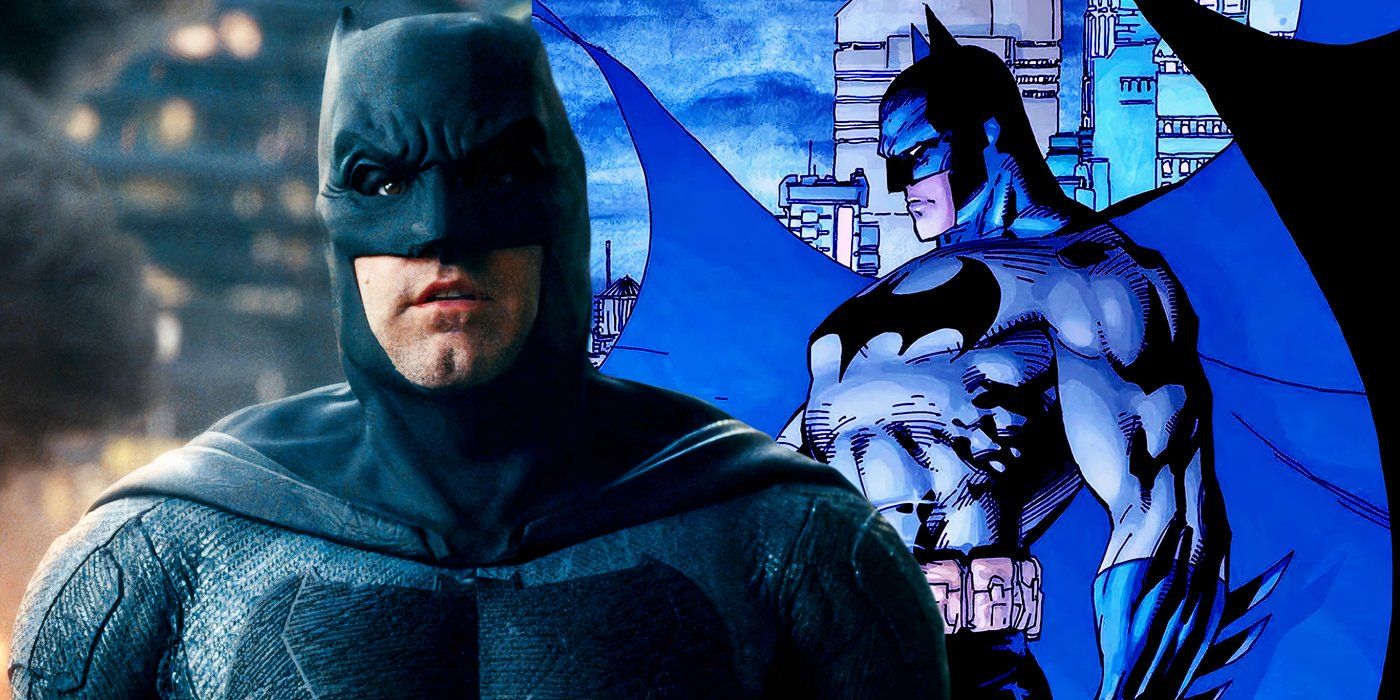[[{“value”:”
Summary
Each Batman movie adaptation showcases the Caped Crusader in unique ways, from campy charm to gritty realism, while lifting scenes from the comics.
Significant comic book moments, such as the Joker killing Robin, are faithfully adapted in live-action Batman movies like Batman v Superman.
Though many of the Batman movies crafted their own unique identity, they still drew inspiration from the pages of DC Comics. From the campy charm of the 1960s Adam West era to the dark and gritty realism of Christopher Nolan’s The Dark Knight trilogy, Batman has been portrayed in various ways across numerous movie franchises. Each adaptation brings its own vision of Gotham’s Caped Crusader to the DCU timeline, while still lifting scenes directly from the comic books.
Batman might be the most popular superhero ever and has been adapted on numerous occasions and in numerous mediums. A total of 13 live-action Batman movies have been produced, along with a swathe of animated movies. While the animated Batman movies have demonstrated a remarkable degree of fidelity to the source material, the live-action movies frequently deviated somewhat. Despite this, numerous scenes from the Batmancomics have been adapted faithfully in live-action movies.
DCU Chapter One Gods And Monsters: Every Movie & Show In The New DC Universe
James Gunn and Peter Safran’s DC Universe begins with six movies and six shows that open the DCU’s first chapter, “Gods and Monsters”.
10 The Wayne’s Murder
Batman (1989)
The murder of Thomas and Martha Wayne is the tragic event that sets Bruce Wayne on his path to becoming Batman. This scene has been depicted in almost every major Batman film, from Tim Burton’s Batman to Zack Snyder’s Batman v Superman: Dawn of Justice. Each adaptation portrays the brutal killing of Bruce’s parents in a dark alley, a scene directly inspired by the comics.
One of the most faithful elements of these adaptations is the depiction of Martha Wayne’s pearls. In Frank Miller’s Batman: Year One and many other comic versions, Martha’s pearls are shown breaking and scattering onto the street as she is shot, a poignant symbol of Bruce’s shattered innocence. The visual of the pearls falling to the ground has become synonymous with the Wayne murders, and every film that has depicted this event has included this detail.
9 Bane Breaks Batman
The Dark Knight Rises
One of the most iconic moments in Batman’s comic book history occurs in Batman #497, when Bane breaks the Dark Knight’s back, leaving him paralyzed and temporarily ending his career as Gotham’s protector. This storyline, known as “Knightfall,” is one of the defining arcs for both Batman and Bane. This moment was faithfully adapted in The Dark Knight Rises, where Bane overpowers Batman in a brutal fight.
Bane ultimately lifts Batman over his head and slams him down on his knee, breaking his back. The scene is almost identical to the comic book version, capturing the sheer physical dominance of Bane and the devastating impact on Batman. This adaptation brings one of the most famous comic book moments to life but also serves as a pivotal turning point in the film, setting the stage for Batman’s eventual return and redemption.
8 Batman V Superman
Batman V Superman: Dawn Of Justice
The battle between Batman and Superman is a clash of titans that has been depicted in various forms over the years. However, one of the most significant inspirations for the cinematic showdown in Batman v Superman: Dawn of Justice comes from Frank Miller’s The Dark Knight Returns. In this seminal comic book, an older, grizzled Batman dons a powerful, armored suit to take on Superman in a battle that questions the very nature of justice and power.
Zack Snyder’s film draws heavily from this storyline, especially in the design of Batman’s armored suit. The suit is a near-perfect recreation of the one used by Batman in The Dark Knight Returns, complete with glowing eyes and bulky, reinforced frame. The fight itself also mirrors the comic, with Batman using a combination of strategy, technology, and raw determination to hold his own against the Man of Steel.
10 Amazing Details From Batman Movies You Never Noticed
The Batman movies are brimming with incredible details and Easter eggs, foreshadowing major events and celebrating its iconic comic book history.
7 Joker Murders Robin
Batman V Superman: Dawn Of Justice
In Batman v Superman: Dawn of Justice, a brief but chilling scene reveals that the Joker has previously killed Robin. Bruce Wayne is depicted as keeping Robin’s defaced uniform displayed in the Batcave as a grim reminder of his failure. This moment is a direct reference to the infamous comic book storyline “A Death in the Family” (Batman #426–429), where the second Robin, Jason Todd, is brutally murdered by the Joker.
In “A Death in the Family,” DC Comics readers voted for Jason Todd to be killed off. As a result, the Joker beats Jason Todd with a crowbar before leaving him to die in an explosion. The death of Robin was a watershed moment in Batman’s history, plunging him into deeper darkness and solidifying his resolve against crime. The film adaptation captures the somber tone of this event, hinting at the emotional scars that Batman carries as a result of this tragedy.
6 Joker Disguised As A Police Officer
The Dark Knight
One of the most suspenseful scenes in The Dark Knight is when the Joker disguises himself as a police officer in an assassination attempt. This chilling moment is directly inspired by the Joker’s debut story in the comics from 1940. In the original story, simply titled “The Joker,” the villain targets Judge Drake, who has been placed under protective custody after being named as the Joker’s next victim – another plot point repeated in The Dark Knight.
In the comic, the Joker infiltrates the protective detail by disguising himself as one of the police officers. The tension builds as the Joker gets closer to his target, revealing his true identity in a shocking twist. Christopher Nolan’s adaptation of this scene in The Dark Knight captures the same sense of dread and unpredictability, combining it with several elements from Joker’s comic book debut.
5 Batman Visits Two-Face In Hospital
The Dark Knight
In The Dark Knight, a powerful scene occurs where Christian Bale’s Batman visits Harvey Dent, who has now become Two-Face, in the hospital. The scene is deeply reminiscent of the comic book series Dark Detective II. In the comics, Batman confronts Two-Face while the latter is recovering from injuries inflicted by the Joker’s explosive trap and returns the villain’s famed coin – much like the movie.
The encounter between Batman and Two-Face is laden with tension and tragedy in both the film and the comic. The lingering shots of Two-Face’s coin, a symbol of his fractured psyche, are especially reminiscent of the comic, serving in both to further emphasize the duality and internal conflict that defines the villain. The scene in The Dark Knight masterfully captures the essence of this relationship, portraying Batman’s guilt and responsibility for Harvey’s transformation, while Two-Face grapples with his new identity.
4 Batman’s Bat Flashback
Batman Forever
One of the more surreal moments in Batman Forever occurs in a flashback when a young Bruce Wayne falls into a cave and encounters a giant bat. This scene is a direct adaptation of The Dark Knight Returns by Frank Miller, where Bruce experiences a similar vision. In the comic, the bat is a manifestation of Bruce’s fear and trauma, representing the darkness that he will ultimately embrace as Batman.
The imagery of the bat swooping down at the young Bruce is both terrifying and transformative, marking the moment when Bruce’s fate as Gotham’s protector is sealed. Batman Forever translates this scene to the big screen, using the bat as a metaphor for Bruce’s inner turmoil and the birth of his alter ego. Although the film takes a more fantastical approach, the essence of the comic book moment is preserved, illustrating how Batman’s identity is intrinsically tied to his fear.
3 Cats surround Selina Kyle’s Body
Batman Returns
In Batman Returns, one of the most haunting scenes involves Selina Kyle being pushed out of a window by her boss, Max Shreck, and left for dead in an alley. As she lies motionless on the ground, a group of cats surrounds her, seemingly bringing her back to life. This moment is a direct nod to the comic Catwoman: Her Sister’s Keeper, which begins with a similarly brutal scene.
In the comic, Selina is beaten and left for dead by her pimp, only to be discovered by a group of cats. This traumatic experience marks the beginning of her transformation into Catwoman, as she decides to take control of her life and seek revenge on those who wronged her. Tim Burton’s adaptation of this scene in Batman Returns captures the same sense of rebirth and empowerment, with the cats serving as both witnesses to Selina’s suffering and catalysts for her transformation.
10 Best Batman Gadgets In Michael Keaton’s Movies
Michael Keaton’s Batman used many iconic gadgets throughout Tim Burton’s Batman movies, helping to foster some of the most iconic depictions ever.
Batman Forever
In Batman Forever, Dr. Meridian Chase uses the Bat-Signal to summon Batman. However, it is not for crime-fighting purposes, but to pursue a romantic relationship. This playful moment is actually inspired by a similar event in the comics, specifically in “Hot House” (Legends of the Dark Knight #42, February 1993).
In the comic, a woman misuses the Bat-Signal to summon Batman for her own personal reasons, much like Meridian does in the film. Both scenes highlight the allure and mystique of Batman, as well as the lengths to which certain characters will go to gain his attention. While the tone of this scene in Batman Forever is lighthearted and flirtatious, it nonetheless pays homage to a similar scenario in the comics, demonstrating how Batman’s iconic symbol can be repurposed in various ways, both serious and humorous.
1 Joker Falls Into Acid
Batman (1989)
One of the most enduring images in Batman lore is the transformation of the Joker, which is often depicted as occurring after he falls into a vat of chemicals. This origin story was first introduced in the Pre-Crisis comics, specifically in Detective Comics #168, “The Man Behind the Red Hood” by Bill Finger. In this story, a criminal known as the Red Hood falls into a vat of chemicals during a confrontation with Batman, emerging as the Joker with his signature white skin, green hair, and red lips.
Tim Burton’s Batman brought this origin story to the big screen, with Joker being similarly transformed after a chemical bath. The scene has since become a staple of Joker’s cinematic portrayals, referenced in various forms in subsequent films and media. The acid bath is a crucial element of the Joker’s backstory, symbolizing his descent into madness and the birth of one of Batman’s most iconic enemies.
Upcoming DC Movie Releases
“}]] Batman movies frequently recreated DC Comics Read More

